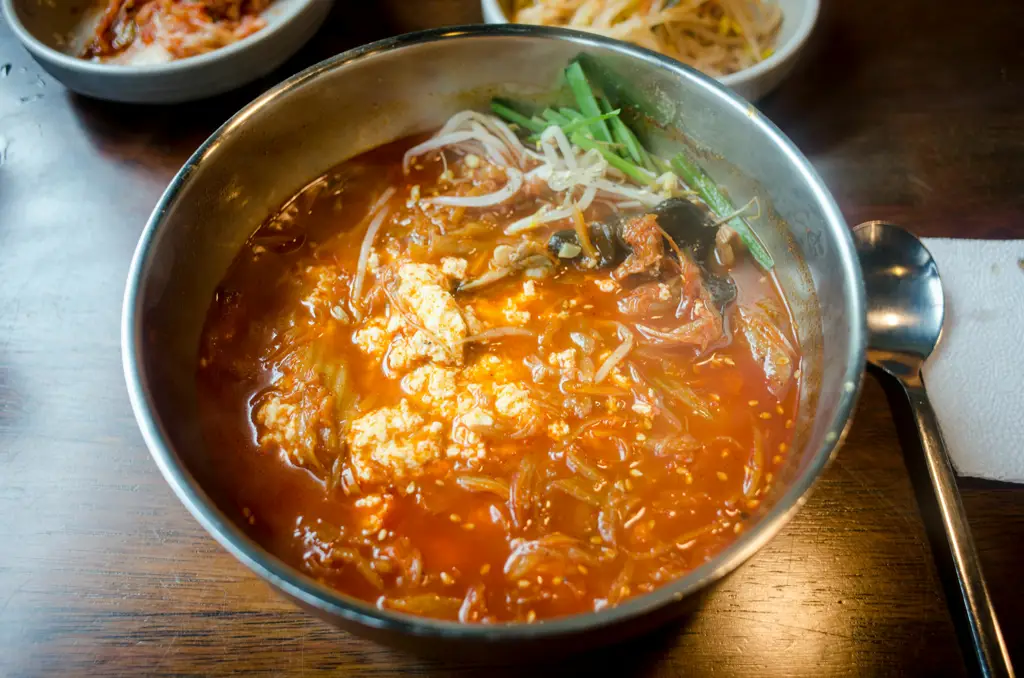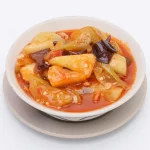Tofu, a staple in East Asian cuisine for centuries, forms the heart of this delicious and nutritious stir-fry. Its origins trace back to ancient China, possibly as early as the 2nd century CE during the Han dynasty, where it was initially created as a way to preserve soybeans. Soybeans, a powerhouse of protein, were and continue to be a critical part of many Asian diets, and tofu provided a readily available and versatile protein source, particularly for Buddhist monks who abstained from meat. The process of making tofu involves grinding soybeans, boiling them to create soymilk, then coagulating the milk using a salt solution (nigari) or other agents, resulting in a firm, white curd.
Over time, tofu spread throughout East and Southeast Asia, adapting to local tastes and culinary traditions. In Japan, it became known as tōfu and is a key ingredient in countless dishes, from miso soup to sushi. In Korea, it’s called dubu and features prominently in stews, pancakes (dubu jorim), and other savory preparations. Across these cultures, tofu’s versatility shines – it readily absorbs flavors, making it a perfect blank canvas for sauces and spices. Its neutral taste allows it to complement a wide array of vegetables and proteins, which is why it is perfect for stir fries.
Today, tofu’s popularity extends far beyond Asia. Globally, the tofu market is booming, with estimates projecting significant growth in the coming years. This surge in popularity is driven by its nutritional benefits – it’s a complete protein, meaning it contains all nine essential amino acids, and is low in calories and fat, while being a good source of iron and calcium. Furthermore, tofu’s adaptability to various cuisines and diets (vegetarian, vegan, and others) contributes to its widespread appeal. This recipe for tofu stir-fry with veggies is a testament to its enduring versatility and deliciousness, showcasing its ability to be both a healthy and flavorful centerpiece of a meal.
Ingredients and Measurements
This recipe yields approximately 4 servings of delicious and healthy Tofu Stir-Fry with Veggies. Accurate measurements are crucial for achieving the perfect balance of flavors and textures. Use a kitchen scale for the most precise measurements, especially for the tofu and vegetables.
Tofu: 1 block (14 ounces) extra-firm tofu. Extra-firm tofu holds its shape best during stir-frying. Pressing the tofu is highly recommended to remove excess water. Wrap the block in several layers of paper towels and place a heavy object (like books or weights) on top for at least 30 minutes to an hour. This prevents the tofu from becoming soggy in the stir-fry.
Vegetables: The beauty of stir-fries lies in their versatility. Feel free to substitute your favorite vegetables, keeping in mind the cooking times. Here’s a suggested combination:
- 1 bell pepper (any color), thinly sliced (approximately 1 cup)
- 1 medium onion, thinly sliced (approximately 1 cup)
- 1 cup broccoli florets
- 1 cup sliced carrots
- 1/2 cup snow peas or snap peas
Important Note: Cut all vegetables into consistently sized pieces to ensure even cooking. Aim for bite-sized pieces that will cook through within the same timeframe.
Sauce: The sauce is the heart of this stir-fry. The following measurements create a well-balanced flavor profile. Feel free to adjust to your preference, adding more soy sauce for saltiness or more honey for sweetness.
- 1/4 cup soy sauce (low sodium preferred)
- 2 tablespoons honey or maple syrup
- 2 tablespoons rice vinegar
- 1 tablespoon cornstarch
- 1 tablespoon sesame oil
- 1 teaspoon grated ginger
- 1 clove garlic, minced
Other:
- 2 tablespoons vegetable oil or your preferred cooking oil
- Optional: 1/4 cup chopped green onions for garnish
- Optional: Sesame seeds for garnish
Pro Tip: Prepare all your ingredients – washing, chopping, and measuring – before you begin cooking. This ensures a smooth and efficient cooking process, especially important for stir-fries where timing is key.
Equipment and Utensils
To successfully make a delicious tofu stir-fry with vegetables, you’ll need the right equipment and utensils. Having everything prepared beforehand will streamline the cooking process and ensure a smooth, efficient experience. Let’s go through the essentials.
Wok or Large Skillet: A wok is traditionally used for stir-fries due to its curved sides and large surface area, allowing for even cooking and quick movement of ingredients. However, a large, heavy-bottomed skillet (12-14 inches in diameter) is an excellent substitute, especially if you’re short on space. The key is to have a pan that can accommodate all your ingredients without overcrowding.
Cutting Board and Sharp Knives: You’ll need a sturdy cutting board and a set of sharp knives for prepping your vegetables and tofu. A chef’s knife (8-10 inches) is ideal for chopping vegetables, while a smaller paring knife is handy for more detailed work. Sharp knives are crucial for clean cuts, which ensure even cooking and better texture. Dull knives can lead to unevenly cooked vegetables and a less appealing final product.
Measuring Cups and Spoons: Accurate measurements are important for balancing flavors and ensuring the stir-fry isn’t too watery or too dry. Invest in a set of reliable measuring cups and spoons to achieve consistent results. Use both dry and liquid measuring cups for accurate ingredient proportions.
Spatula or Spatula/Tongs Combo: A wide spatula is essential for tossing the ingredients in the wok or skillet and ensuring even cooking. Consider having both a spatula and tongs; tongs are particularly helpful for flipping larger pieces of tofu or vegetables without breaking them. A heat-resistant spatula is recommended to withstand the high temperatures of stir-frying.
Colander: A colander is needed to drain excess water from the pressed tofu. This step is crucial for achieving a crispy exterior and preventing a soggy stir-fry. Choose a colander that’s large enough to accommodate the amount of tofu you’re using.
Large Bowl: A large bowl is useful for mixing the sauce ingredients and for temporarily holding the prepared vegetables before adding them to the wok. A bowl with a non-slip base is helpful to prevent spills during mixing.
Paper Towels: Paper towels are useful for patting the pressed tofu dry and for wiping up any spills during the cooking process. Having plenty of paper towels on hand will make cleanup much easier.
Preparing the Tofu (Pressing, Cubing)
Before we dive into the stir-fry, proper tofu preparation is key to achieving a delicious and satisfying dish. Firm or extra-firm tofu works best for stir-fries; silken tofu is too delicate and will crumble. We’ll start by pressing the tofu to remove excess water, which prevents a soggy stir-fry and allows for better browning and crisping.
Pressing the Tofu: There are several ways to press tofu, ranging from simple to more advanced. The simplest method involves wrapping a block of 14-ounce (400g) firm or extra-firm tofu in several layers of paper towels. Place this package on a plate, then top it with another plate and a heavy object, such as a stack of books or a cast iron skillet, for at least 30 minutes. The longer you press, the firmer and drier your tofu will become. For best results, aim for at least an hour, or even longer if time allows.
Alternatively, you can use a tofu press, which is a more efficient method for removing excess water. These presses are readily available online or in kitchen stores. Follow the manufacturer’s instructions for optimal results. Regardless of your chosen method, ensure the tofu is evenly pressed to avoid uneven cooking.
Cubing the Tofu: Once the tofu is sufficiently pressed, it’s time to cut it into cubes. Using a sharp knife, cut the tofu block into 1-inch (2.5cm) cubes. A sharp knife ensures clean cuts and prevents the tofu from crumbling. If you find the tofu is still slightly soft, you can gently pat the cubes with additional paper towels to absorb any lingering moisture.
Optional: Pan-frying for extra crispiness: For an extra crispy exterior, you can pan-fry the tofu cubes before adding them to the stir-fry. Heat 1 tablespoon of oil (vegetable, canola, or your preferred high-heat oil) in a large skillet over medium-high heat. Add the tofu cubes in a single layer, avoiding overcrowding. Cook for about 5-7 minutes per side, or until golden brown and crispy. Avoid moving the tofu too much while it’s cooking to allow for proper browning. Set aside the cooked tofu before proceeding with the stir-fry.
Properly pressed and cubed tofu will absorb the flavors of the stir-fry beautifully, resulting in a delicious and satisfying meal. Now, let’s move on to preparing the vegetables!
Preparing the Vegetables (Cleaning, Chopping)
Efficient vegetable preparation is key to a successful and flavorful stir-fry. Begin by gathering your chosen vegetables. For this recipe, we’ll use 1 cup broccoli florets, 1 red bell pepper (about 150g), 1/2 cup sliced carrots (approximately 75g), and 1/2 cup snow peas (about 50g). Adjust quantities based on your preferences and the number of servings.
First, thoroughly wash all vegetables under cold running water. Remove any blemishes or damaged parts. For the broccoli, break it into bite-sized florets. If using a large head of broccoli, you might want to cut the stalk into smaller pieces as well, ensuring even cooking. Avoid overly small florets, as they may overcook and become mushy.
Next, prepare the bell pepper. Cut it in half lengthwise, remove the stem, seeds, and membranes. Then, slice it into thin strips, approximately 1/4 inch wide. Consistent sizing ensures even cooking and a pleasant texture. If you prefer smaller pieces, feel free to dice the pepper instead.
The carrots should be peeled, if necessary, and then sliced into thin rounds or matchsticks. Aim for uniform thickness to prevent some pieces from cooking faster than others. For the snow peas, simply trim the ends and leave them whole or halve them lengthwise, depending on your preference. Avoid over-processing the snow peas as they will become limp quickly.
Once all the vegetables are prepped, it’s helpful to organize them in separate bowls. This will streamline the stir-frying process and prevent any confusion during cooking. Having everything ready before you start cooking is crucial for maintaining a consistent cooking temperature and preventing overcooking. This organized approach ensures a smooth and efficient cooking experience, resulting in a delicious and perfectly cooked tofu stir-fry.
Tip: For faster prep, consider using a mandoline slicer for even slicing of carrots and bell peppers. However, always exercise caution when using sharp kitchen tools.
Sauce Preparation
The sauce is the key to a delicious tofu stir-fry, balancing the savory, sweet, and tangy notes to perfection. We’ll be making a simple yet flavorful sauce that complements the tofu and vegetables beautifully. This recipe makes enough sauce for 2-3 servings.
Begin by gathering your ingredients: 2 tablespoons of soy sauce (or tamari for gluten-free), 1 tablespoon of rice vinegar, 1 tablespoon of sesame oil, 1 tablespoon of honey or maple syrup (adjust to your preferred sweetness), 1 teaspoon of cornstarch, and ½ teaspoon of grated ginger. You can also add a pinch of red pepper flakes for a touch of heat, if desired. Having all your ingredients measured and ready before you start will streamline the process.
In a small bowl, whisk together the soy sauce, rice vinegar, and sesame oil. Ensure you whisk thoroughly to combine these ingredients completely; this prevents any separation in the final sauce. This is crucial for achieving a uniform flavor and consistency. The sesame oil adds a wonderful aroma and depth of flavor.
Next, add the honey or maple syrup. Taste the mixture and adjust the sweetness according to your preference. Some prefer a sweeter sauce, while others prefer a more savory one. This step allows you to personalize the sauce to your liking.
In a separate small bowl, whisk the cornstarch with 1-2 tablespoons of cold water until completely dissolved. This creates a smooth slurry that will thicken the sauce. Adding the cornstarch slurry directly without mixing it with water can result in lumps. This is a common mistake, so take your time here!
Slowly pour the cornstarch slurry into the soy sauce mixture, whisking continuously to prevent clumping. Continue whisking until the sauce is smooth and there are no visible cornstarch particles. This ensures that the sauce will thicken evenly when heated.
Finally, stir in the grated ginger. The ginger adds a subtle warmth and complexity to the sauce. If using red pepper flakes, add them now as well. Your sauce is now ready to be added to your stir-fry during the final cooking stage. Remember to add the sauce towards the end of the cooking process to allow it to thicken properly without burning.
Stir-frying the Tofu
Once your vegetables are prepped, it’s time to tackle the tofu. We’ll be stir-frying it to achieve a beautifully crispy exterior and a tender interior. Begin with 14 ounces (400g) of firm or extra-firm tofu, pressed to remove excess water. This step is crucial for achieving that satisfyingly crisp texture. Pressing the tofu is best done by wrapping it in a clean kitchen towel and placing a heavy object on top for at least 30 minutes. Alternatively, you can use a tofu press for quicker results.
Next, cut the pressed tofu into bite-sized cubes, approximately ½ inch (1.25 cm). This ensures even cooking and prevents large pieces from becoming soggy. In a medium bowl, toss the tofu cubes with 1 tablespoon of cornstarch. The cornstarch will act as a binding agent, helping to create a crisp exterior when stir-fried. Add ½ teaspoon of salt and ¼ teaspoon of black pepper for seasoning. Gently toss to ensure all the tofu pieces are evenly coated.
Heat 2 tablespoons of vegetable oil in a large wok or skillet over medium-high heat. It’s important to use a wok or a pan with high sides to prevent the oil from splattering. Once the oil is hot enough (you should see a slight shimmer), carefully add the tofu cubes in a single layer, avoiding overcrowding the pan. Overcrowding will lead to steaming instead of stir-frying, resulting in soggy tofu.
Stir-fry the tofu for about 5-7 minutes, ensuring that all sides are golden brown and crispy. Avoid constantly moving the tofu; let it develop a good sear on each side before stirring. If necessary, work in batches to ensure even cooking. Once the tofu is cooked, remove it from the pan and set it aside. You can leave it on a plate lined with paper towels to absorb any excess oil.
Remember to adjust cooking time depending on your stovetop and the size of your tofu cubes. Smaller cubes will cook faster than larger ones. Keep a close eye on the tofu to prevent burning. Once you’ve mastered the technique of stir-frying tofu, you’ll be amazed at how delicious and versatile this protein can be in your stir-fry creations.
Recommendations
For the best tofu stir-fry experience, we highly recommend pressing your tofu thoroughly before cooking to remove excess water and achieve a firmer, crispier texture. Experiment with different types of tofu – firm or extra-firm work best for stir-fries. Don’t be afraid to get creative with your vegetables! Feel free to substitute your favorite veggies based on seasonality and availability. Adding a splash of your favorite sauce at the end elevates the dish.
Serving Suggestions: This tofu stir-fry is delicious served over steamed rice, quinoa, or brown rice for a complete and satisfying meal. It also pairs wonderfully with noodles, such as soba or udon. For a more substantial meal, consider serving it with a side of steamed dumplings or egg rolls. Garnished with chopped green onions or sesame seeds adds a nice visual appeal and extra flavor.
Storage: Leftovers can be stored in an airtight container in the refrigerator for up to 3-4 days. Avoid reheating in the microwave as it can make the tofu rubbery. Instead, gently reheat it in a pan over medium heat, adding a little water or broth if needed.
Nutritional Information (Approximate per serving, based on a 4-serving recipe): Calories: 300-400 (depending on ingredients and oil used); Protein: 20-25g; Fiber: 6-8g. This is a rough estimate, and the exact nutritional content will vary depending on the specific ingredients and portion sizes used. For precise nutritional information, use a nutrition calculator and input your specific ingredients and quantities.
Complementary Dishes: This tofu stir-fry complements a variety of dishes. It pairs well with lighter appetizers like spring rolls or edamame. For a more substantial meal, serve it alongside a miso soup or a simple salad with a light vinaigrette. Consider offering a spicy dipping sauce on the side for those who like a little extra heat. Remember to adjust seasonings to suit your personal preferences.
Important Note: The calorie and nutritional information provided is an estimate and may vary depending on the specific ingredients used and portion sizes. Always consult a nutritionist or dietitian for personalized dietary advice.





